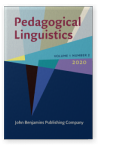Vol. 1:2 (2020) ► pp.125–148
Towards a functional literacy approach to teach the language of science in the Singapore classroom
This paper describes a pilot study exploring how an approach drawing on systemic functional linguistics can inform science teaching. This study is an exploratory effort between researchers from a linguistics background and secondary school science teachers in the Singapore science classroom. The teachers designed activities in the joint construction of texts to support students’ negotiation of meanings and clarification of conceptual understandings. With this, the teachers applied strategies to draw attention to the language of science in their lessons. The study points to the value of the functional literacy approach in science teaching and presents implications on teacher professional learning as well as the role of linguistics in developing disciplinary literacy in students.
Article outline
- 1.Introduction
- 2.Review of literature
- 3.Methodology
- 3.1Adrian: Understanding current teaching practices with a FL lens
- 3.2Brenda: Understanding current teaching practices with a FL lens
- 3.3Data sources and analysis procedures
- 4.Findings
- 4.1Harnessing the FL approach on the joint construction of texts: Adrian
- 4.2Harnessing the FL approach on the joint construction of texts: Brenda
- 4.3Benefits
- 5.Discussion
- 6.Conclusion
- Declaration of interest statement
-
References
